Analyzing Change Management Strategies at Microsoft Corporation
VerifiedAdded on 2022/09/14
|12
|2945
|22
Case Study
AI Summary
This case study delves into the intricacies of change management at Microsoft Corporation, examining the external and internal factors influencing its organizational shifts. It analyzes the impact of industry trends, competition, and technological advancements on Microsoft's business model. The study explores the dynamics of organizational change, including changes in structure, strategy, remedies, and people, and how Microsoft leverages tools like the ERP system, Microsoft Dynamics 365, to enhance efficiency. Furthermore, it applies the McKinsey 7s model to assess Microsoft's strategy, structure, systems, shared values, skills, staff, and style. The case study also highlights effective change management approaches, including leadership strategies, and the impact of leaders like Satya Nadella. Overall, the analysis provides insights into Microsoft's ability to adapt to market demands, innovate, and maintain a competitive edge through strategic organizational changes.
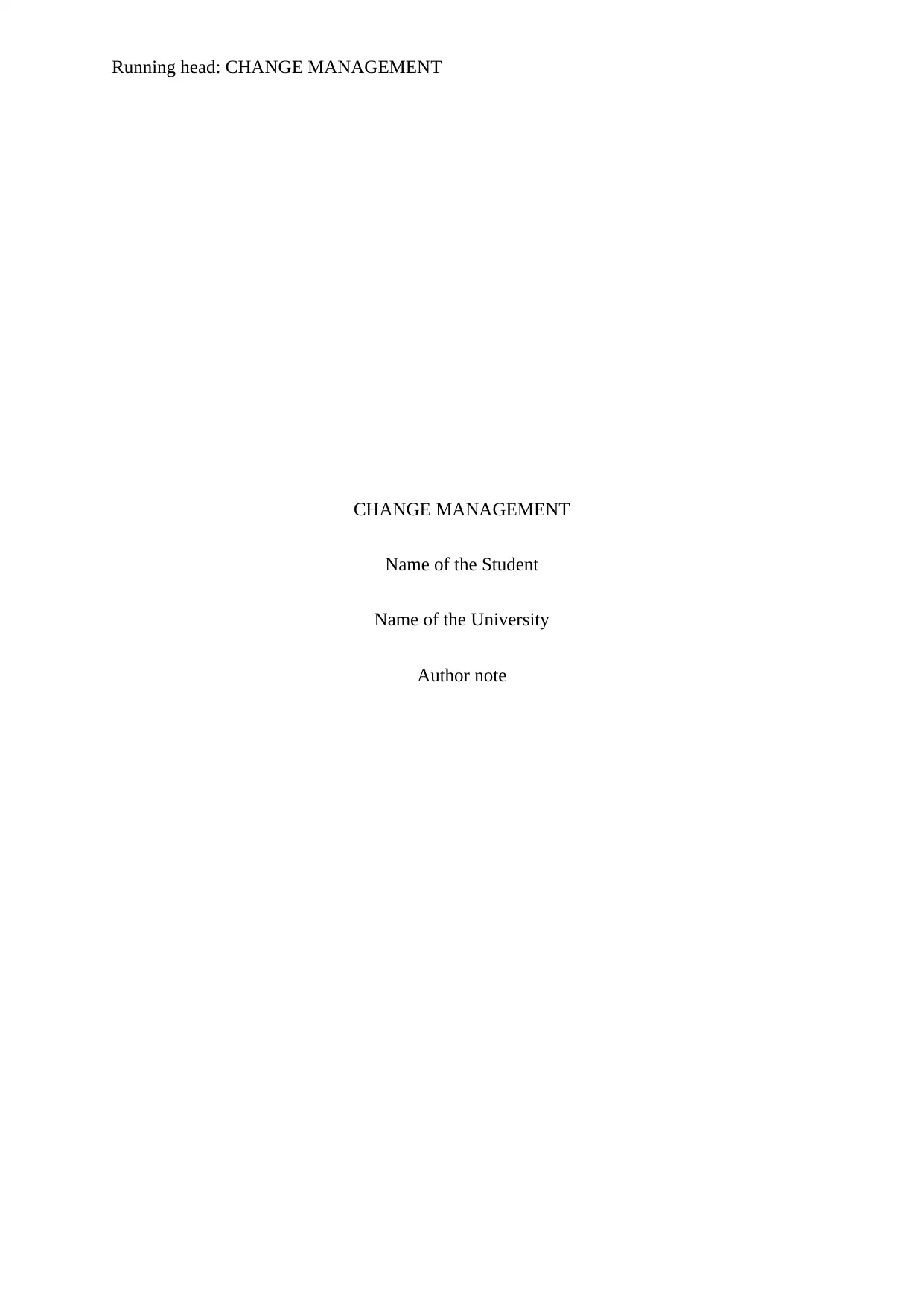
Running head: CHANGE MANAGEMENT
CHANGE MANAGEMENT
Name of the Student
Name of the University
Author note
CHANGE MANAGEMENT
Name of the Student
Name of the University
Author note
Paraphrase This Document
Need a fresh take? Get an instant paraphrase of this document with our AI Paraphraser

1CHANGE MANAGEMENT
Table of Contents
Introduction................................................................................................................................2
Discussion..................................................................................................................................3
External factors influencing organizational change in Microsoft..........................................3
Analysis of changes in Microsoft...........................................................................................4
Dynamics of organizational change in Microsoft..................................................................5
Effective change management in Microsoft..........................................................................7
Conclusion..................................................................................................................................8
References................................................................................................................................10
Table of Contents
Introduction................................................................................................................................2
Discussion..................................................................................................................................3
External factors influencing organizational change in Microsoft..........................................3
Analysis of changes in Microsoft...........................................................................................4
Dynamics of organizational change in Microsoft..................................................................5
Effective change management in Microsoft..........................................................................7
Conclusion..................................................................................................................................8
References................................................................................................................................10
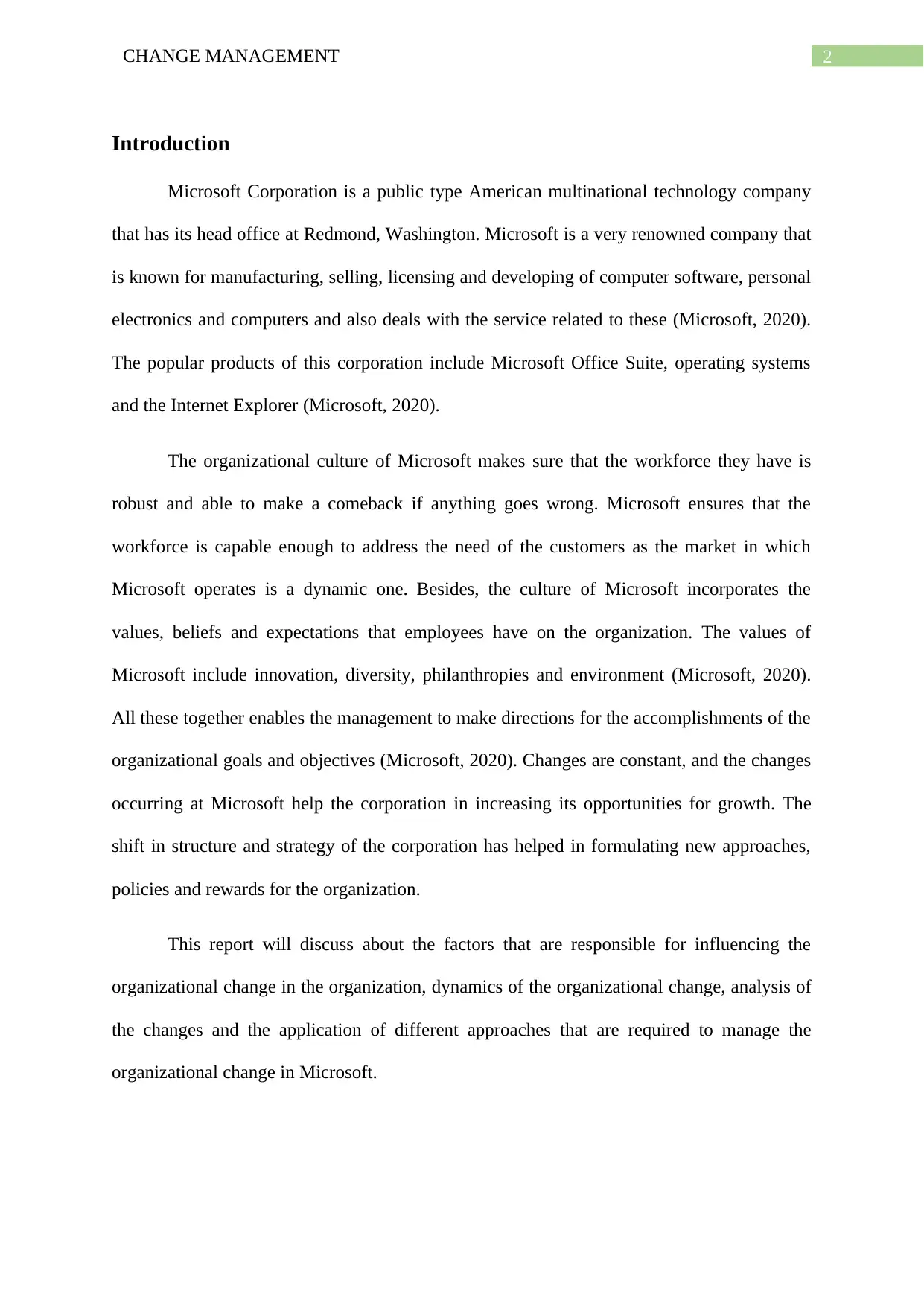
2CHANGE MANAGEMENT
Introduction
Microsoft Corporation is a public type American multinational technology company
that has its head office at Redmond, Washington. Microsoft is a very renowned company that
is known for manufacturing, selling, licensing and developing of computer software, personal
electronics and computers and also deals with the service related to these (Microsoft, 2020).
The popular products of this corporation include Microsoft Office Suite, operating systems
and the Internet Explorer (Microsoft, 2020).
The organizational culture of Microsoft makes sure that the workforce they have is
robust and able to make a comeback if anything goes wrong. Microsoft ensures that the
workforce is capable enough to address the need of the customers as the market in which
Microsoft operates is a dynamic one. Besides, the culture of Microsoft incorporates the
values, beliefs and expectations that employees have on the organization. The values of
Microsoft include innovation, diversity, philanthropies and environment (Microsoft, 2020).
All these together enables the management to make directions for the accomplishments of the
organizational goals and objectives (Microsoft, 2020). Changes are constant, and the changes
occurring at Microsoft help the corporation in increasing its opportunities for growth. The
shift in structure and strategy of the corporation has helped in formulating new approaches,
policies and rewards for the organization.
This report will discuss about the factors that are responsible for influencing the
organizational change in the organization, dynamics of the organizational change, analysis of
the changes and the application of different approaches that are required to manage the
organizational change in Microsoft.
Introduction
Microsoft Corporation is a public type American multinational technology company
that has its head office at Redmond, Washington. Microsoft is a very renowned company that
is known for manufacturing, selling, licensing and developing of computer software, personal
electronics and computers and also deals with the service related to these (Microsoft, 2020).
The popular products of this corporation include Microsoft Office Suite, operating systems
and the Internet Explorer (Microsoft, 2020).
The organizational culture of Microsoft makes sure that the workforce they have is
robust and able to make a comeback if anything goes wrong. Microsoft ensures that the
workforce is capable enough to address the need of the customers as the market in which
Microsoft operates is a dynamic one. Besides, the culture of Microsoft incorporates the
values, beliefs and expectations that employees have on the organization. The values of
Microsoft include innovation, diversity, philanthropies and environment (Microsoft, 2020).
All these together enables the management to make directions for the accomplishments of the
organizational goals and objectives (Microsoft, 2020). Changes are constant, and the changes
occurring at Microsoft help the corporation in increasing its opportunities for growth. The
shift in structure and strategy of the corporation has helped in formulating new approaches,
policies and rewards for the organization.
This report will discuss about the factors that are responsible for influencing the
organizational change in the organization, dynamics of the organizational change, analysis of
the changes and the application of different approaches that are required to manage the
organizational change in Microsoft.
⊘ This is a preview!⊘
Do you want full access?
Subscribe today to unlock all pages.

Trusted by 1+ million students worldwide

3CHANGE MANAGEMENT
Discussion
External factors influencing organizational change in Microsoft
The external, as well as internal factors of the environment, plays a very crucial role
in the performance of the organization by providing a brief assessment of the influences that
external and the internal environment has on the business (Rizescu and Tileag 2016). The
internal environment includes factors like strengths and weaknesses of Microsoft, whereas,
the external analysis constitutes opportunities and threats of Microsoft Corporation (Lopez
2018).
Internal environment analysis:
Strengths: the primary advantage of Microsoft is its human resource. There are around 8,414
employees across the world all working for Microsoft. The organization is known to pay high
and provide a lot of benefits to its employees. Besides, the corporation has the ability to
operate across several cultures and bring in diversity (Hou and Ting 2017). Hence, the
strength of Microsoft to reach international markets becomes easy. Microsoft is one of the
leading software company having a massive capitalization of the market as well as high brand
image and reputation.
Weaknesses: the major weakness of the corporation is the development of new products. The
processing of the new product is quite slow in the organization, and this turns out to be a
major weakness for Microsoft.
External environment analysis:
Opportunities: the growth rate of the economies that are emerging is high, and around 46 per
cent of the revenue generated by Microsoft Corporation is through these emerging markets.
Besides, the entertainment business of Microsoft is bound to play a major role in the coming
Discussion
External factors influencing organizational change in Microsoft
The external, as well as internal factors of the environment, plays a very crucial role
in the performance of the organization by providing a brief assessment of the influences that
external and the internal environment has on the business (Rizescu and Tileag 2016). The
internal environment includes factors like strengths and weaknesses of Microsoft, whereas,
the external analysis constitutes opportunities and threats of Microsoft Corporation (Lopez
2018).
Internal environment analysis:
Strengths: the primary advantage of Microsoft is its human resource. There are around 8,414
employees across the world all working for Microsoft. The organization is known to pay high
and provide a lot of benefits to its employees. Besides, the corporation has the ability to
operate across several cultures and bring in diversity (Hou and Ting 2017). Hence, the
strength of Microsoft to reach international markets becomes easy. Microsoft is one of the
leading software company having a massive capitalization of the market as well as high brand
image and reputation.
Weaknesses: the major weakness of the corporation is the development of new products. The
processing of the new product is quite slow in the organization, and this turns out to be a
major weakness for Microsoft.
External environment analysis:
Opportunities: the growth rate of the economies that are emerging is high, and around 46 per
cent of the revenue generated by Microsoft Corporation is through these emerging markets.
Besides, the entertainment business of Microsoft is bound to play a major role in the coming
Paraphrase This Document
Need a fresh take? Get an instant paraphrase of this document with our AI Paraphraser
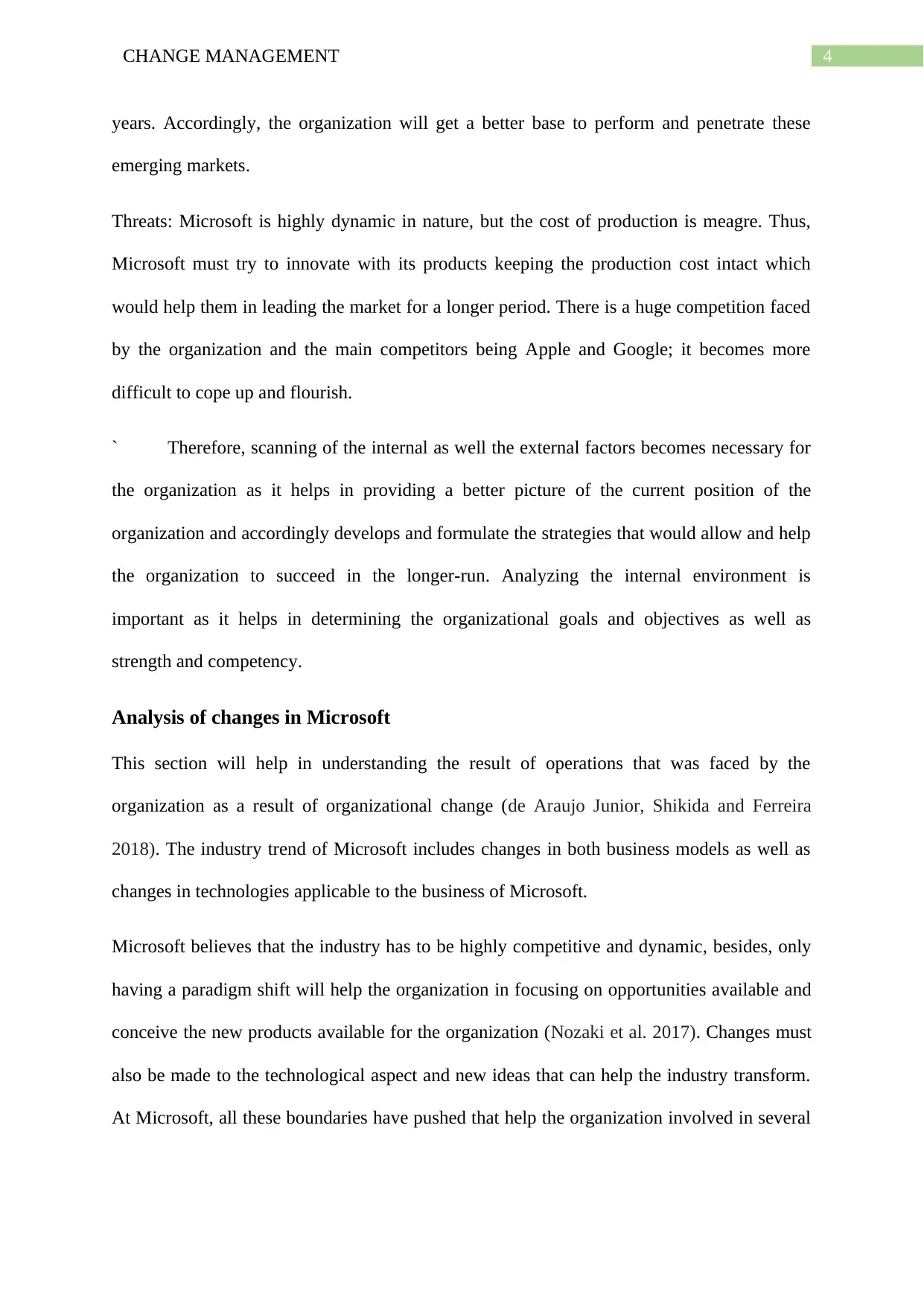
4CHANGE MANAGEMENT
years. Accordingly, the organization will get a better base to perform and penetrate these
emerging markets.
Threats: Microsoft is highly dynamic in nature, but the cost of production is meagre. Thus,
Microsoft must try to innovate with its products keeping the production cost intact which
would help them in leading the market for a longer period. There is a huge competition faced
by the organization and the main competitors being Apple and Google; it becomes more
difficult to cope up and flourish.
` Therefore, scanning of the internal as well the external factors becomes necessary for
the organization as it helps in providing a better picture of the current position of the
organization and accordingly develops and formulate the strategies that would allow and help
the organization to succeed in the longer-run. Analyzing the internal environment is
important as it helps in determining the organizational goals and objectives as well as
strength and competency.
Analysis of changes in Microsoft
This section will help in understanding the result of operations that was faced by the
organization as a result of organizational change (de Araujo Junior, Shikida and Ferreira
2018). The industry trend of Microsoft includes changes in both business models as well as
changes in technologies applicable to the business of Microsoft.
Microsoft believes that the industry has to be highly competitive and dynamic, besides, only
having a paradigm shift will help the organization in focusing on opportunities available and
conceive the new products available for the organization (Nozaki et al. 2017). Changes must
also be made to the technological aspect and new ideas that can help the industry transform.
At Microsoft, all these boundaries have pushed that help the organization involved in several
years. Accordingly, the organization will get a better base to perform and penetrate these
emerging markets.
Threats: Microsoft is highly dynamic in nature, but the cost of production is meagre. Thus,
Microsoft must try to innovate with its products keeping the production cost intact which
would help them in leading the market for a longer period. There is a huge competition faced
by the organization and the main competitors being Apple and Google; it becomes more
difficult to cope up and flourish.
` Therefore, scanning of the internal as well the external factors becomes necessary for
the organization as it helps in providing a better picture of the current position of the
organization and accordingly develops and formulate the strategies that would allow and help
the organization to succeed in the longer-run. Analyzing the internal environment is
important as it helps in determining the organizational goals and objectives as well as
strength and competency.
Analysis of changes in Microsoft
This section will help in understanding the result of operations that was faced by the
organization as a result of organizational change (de Araujo Junior, Shikida and Ferreira
2018). The industry trend of Microsoft includes changes in both business models as well as
changes in technologies applicable to the business of Microsoft.
Microsoft believes that the industry has to be highly competitive and dynamic, besides, only
having a paradigm shift will help the organization in focusing on opportunities available and
conceive the new products available for the organization (Nozaki et al. 2017). Changes must
also be made to the technological aspect and new ideas that can help the industry transform.
At Microsoft, all these boundaries have pushed that help the organization involved in several
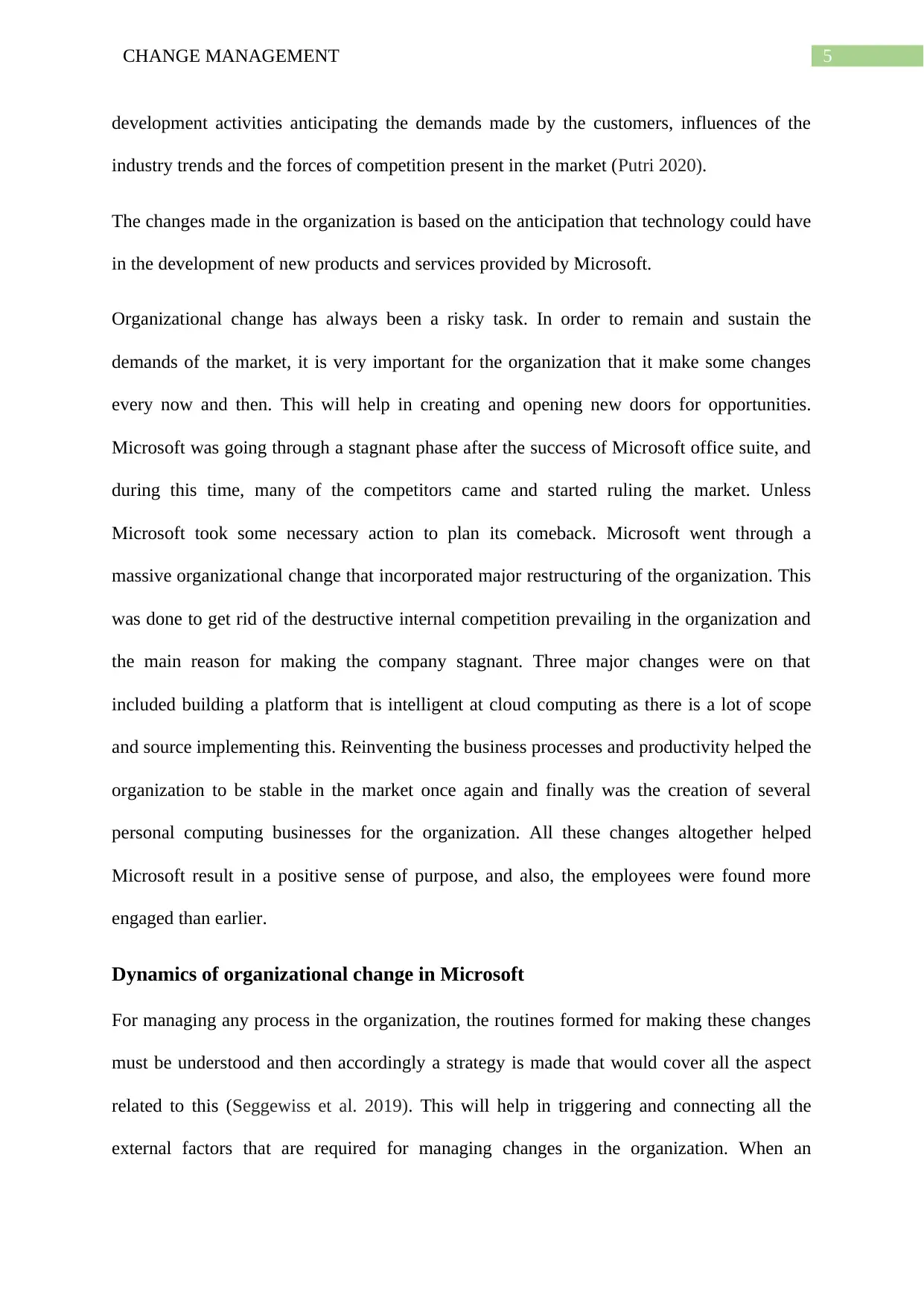
5CHANGE MANAGEMENT
development activities anticipating the demands made by the customers, influences of the
industry trends and the forces of competition present in the market (Putri 2020).
The changes made in the organization is based on the anticipation that technology could have
in the development of new products and services provided by Microsoft.
Organizational change has always been a risky task. In order to remain and sustain the
demands of the market, it is very important for the organization that it make some changes
every now and then. This will help in creating and opening new doors for opportunities.
Microsoft was going through a stagnant phase after the success of Microsoft office suite, and
during this time, many of the competitors came and started ruling the market. Unless
Microsoft took some necessary action to plan its comeback. Microsoft went through a
massive organizational change that incorporated major restructuring of the organization. This
was done to get rid of the destructive internal competition prevailing in the organization and
the main reason for making the company stagnant. Three major changes were on that
included building a platform that is intelligent at cloud computing as there is a lot of scope
and source implementing this. Reinventing the business processes and productivity helped the
organization to be stable in the market once again and finally was the creation of several
personal computing businesses for the organization. All these changes altogether helped
Microsoft result in a positive sense of purpose, and also, the employees were found more
engaged than earlier.
Dynamics of organizational change in Microsoft
For managing any process in the organization, the routines formed for making these changes
must be understood and then accordingly a strategy is made that would cover all the aspect
related to this (Seggewiss et al. 2019). This will help in triggering and connecting all the
external factors that are required for managing changes in the organization. When an
development activities anticipating the demands made by the customers, influences of the
industry trends and the forces of competition present in the market (Putri 2020).
The changes made in the organization is based on the anticipation that technology could have
in the development of new products and services provided by Microsoft.
Organizational change has always been a risky task. In order to remain and sustain the
demands of the market, it is very important for the organization that it make some changes
every now and then. This will help in creating and opening new doors for opportunities.
Microsoft was going through a stagnant phase after the success of Microsoft office suite, and
during this time, many of the competitors came and started ruling the market. Unless
Microsoft took some necessary action to plan its comeback. Microsoft went through a
massive organizational change that incorporated major restructuring of the organization. This
was done to get rid of the destructive internal competition prevailing in the organization and
the main reason for making the company stagnant. Three major changes were on that
included building a platform that is intelligent at cloud computing as there is a lot of scope
and source implementing this. Reinventing the business processes and productivity helped the
organization to be stable in the market once again and finally was the creation of several
personal computing businesses for the organization. All these changes altogether helped
Microsoft result in a positive sense of purpose, and also, the employees were found more
engaged than earlier.
Dynamics of organizational change in Microsoft
For managing any process in the organization, the routines formed for making these changes
must be understood and then accordingly a strategy is made that would cover all the aspect
related to this (Seggewiss et al. 2019). This will help in triggering and connecting all the
external factors that are required for managing changes in the organization. When an
⊘ This is a preview!⊘
Do you want full access?
Subscribe today to unlock all pages.

Trusted by 1+ million students worldwide
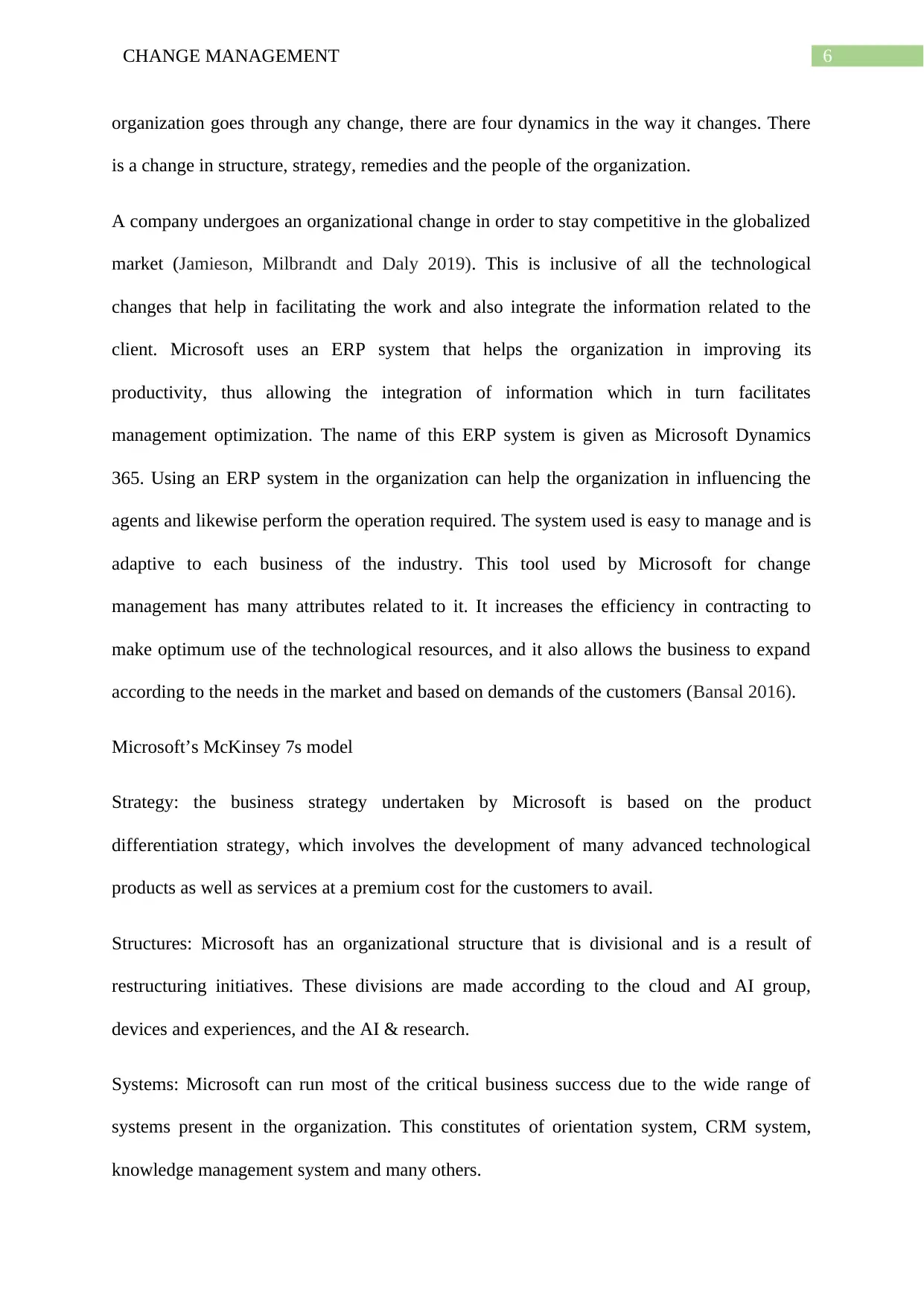
6CHANGE MANAGEMENT
organization goes through any change, there are four dynamics in the way it changes. There
is a change in structure, strategy, remedies and the people of the organization.
A company undergoes an organizational change in order to stay competitive in the globalized
market (Jamieson, Milbrandt and Daly 2019). This is inclusive of all the technological
changes that help in facilitating the work and also integrate the information related to the
client. Microsoft uses an ERP system that helps the organization in improving its
productivity, thus allowing the integration of information which in turn facilitates
management optimization. The name of this ERP system is given as Microsoft Dynamics
365. Using an ERP system in the organization can help the organization in influencing the
agents and likewise perform the operation required. The system used is easy to manage and is
adaptive to each business of the industry. This tool used by Microsoft for change
management has many attributes related to it. It increases the efficiency in contracting to
make optimum use of the technological resources, and it also allows the business to expand
according to the needs in the market and based on demands of the customers (Bansal 2016).
Microsoft’s McKinsey 7s model
Strategy: the business strategy undertaken by Microsoft is based on the product
differentiation strategy, which involves the development of many advanced technological
products as well as services at a premium cost for the customers to avail.
Structures: Microsoft has an organizational structure that is divisional and is a result of
restructuring initiatives. These divisions are made according to the cloud and AI group,
devices and experiences, and the AI & research.
Systems: Microsoft can run most of the critical business success due to the wide range of
systems present in the organization. This constitutes of orientation system, CRM system,
knowledge management system and many others.
organization goes through any change, there are four dynamics in the way it changes. There
is a change in structure, strategy, remedies and the people of the organization.
A company undergoes an organizational change in order to stay competitive in the globalized
market (Jamieson, Milbrandt and Daly 2019). This is inclusive of all the technological
changes that help in facilitating the work and also integrate the information related to the
client. Microsoft uses an ERP system that helps the organization in improving its
productivity, thus allowing the integration of information which in turn facilitates
management optimization. The name of this ERP system is given as Microsoft Dynamics
365. Using an ERP system in the organization can help the organization in influencing the
agents and likewise perform the operation required. The system used is easy to manage and is
adaptive to each business of the industry. This tool used by Microsoft for change
management has many attributes related to it. It increases the efficiency in contracting to
make optimum use of the technological resources, and it also allows the business to expand
according to the needs in the market and based on demands of the customers (Bansal 2016).
Microsoft’s McKinsey 7s model
Strategy: the business strategy undertaken by Microsoft is based on the product
differentiation strategy, which involves the development of many advanced technological
products as well as services at a premium cost for the customers to avail.
Structures: Microsoft has an organizational structure that is divisional and is a result of
restructuring initiatives. These divisions are made according to the cloud and AI group,
devices and experiences, and the AI & research.
Systems: Microsoft can run most of the critical business success due to the wide range of
systems present in the organization. This constitutes of orientation system, CRM system,
knowledge management system and many others.
Paraphrase This Document
Need a fresh take? Get an instant paraphrase of this document with our AI Paraphraser
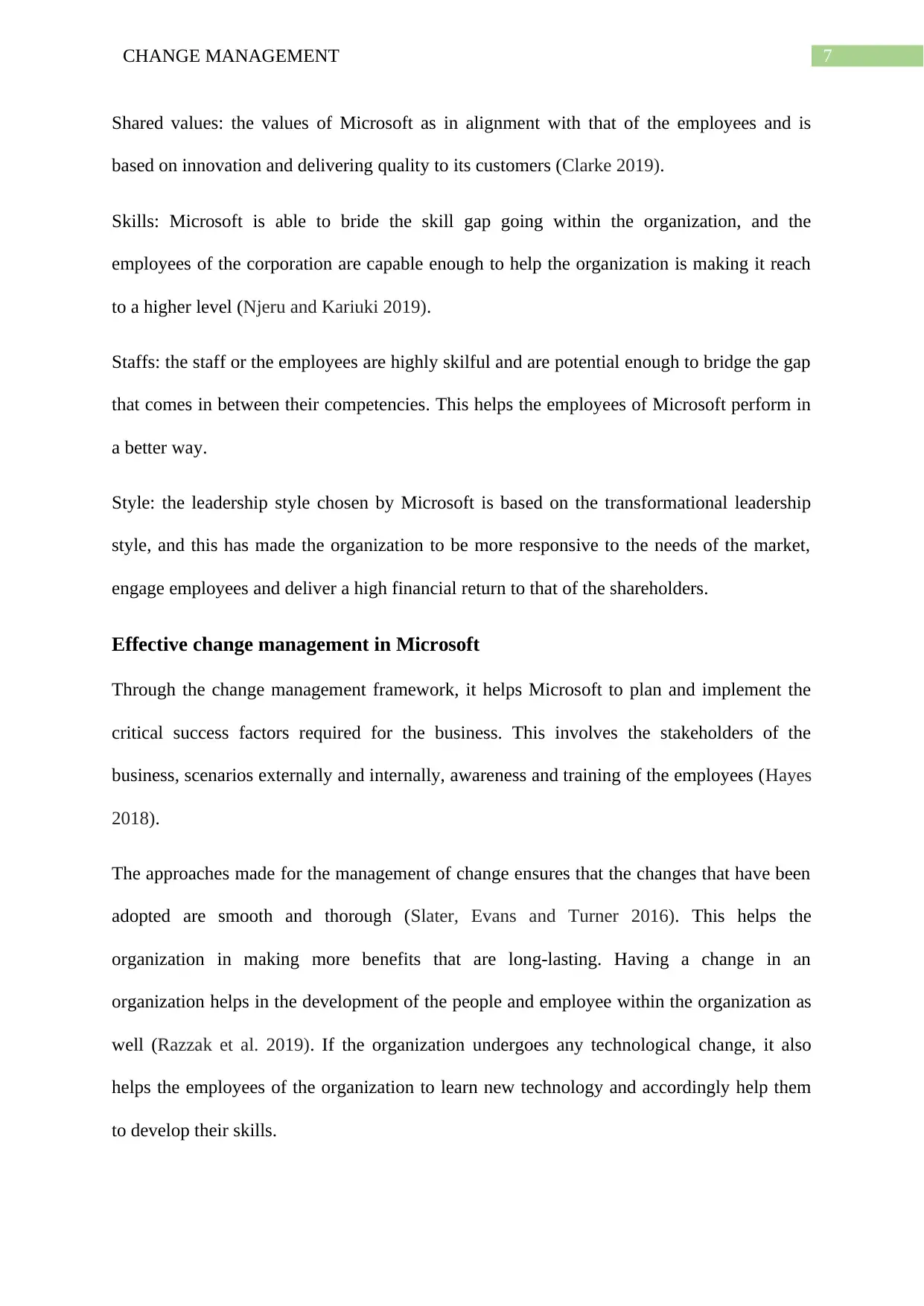
7CHANGE MANAGEMENT
Shared values: the values of Microsoft as in alignment with that of the employees and is
based on innovation and delivering quality to its customers (Clarke 2019).
Skills: Microsoft is able to bride the skill gap going within the organization, and the
employees of the corporation are capable enough to help the organization is making it reach
to a higher level (Njeru and Kariuki 2019).
Staffs: the staff or the employees are highly skilful and are potential enough to bridge the gap
that comes in between their competencies. This helps the employees of Microsoft perform in
a better way.
Style: the leadership style chosen by Microsoft is based on the transformational leadership
style, and this has made the organization to be more responsive to the needs of the market,
engage employees and deliver a high financial return to that of the shareholders.
Effective change management in Microsoft
Through the change management framework, it helps Microsoft to plan and implement the
critical success factors required for the business. This involves the stakeholders of the
business, scenarios externally and internally, awareness and training of the employees (Hayes
2018).
The approaches made for the management of change ensures that the changes that have been
adopted are smooth and thorough (Slater, Evans and Turner 2016). This helps the
organization in making more benefits that are long-lasting. Having a change in an
organization helps in the development of the people and employee within the organization as
well (Razzak et al. 2019). If the organization undergoes any technological change, it also
helps the employees of the organization to learn new technology and accordingly help them
to develop their skills.
Shared values: the values of Microsoft as in alignment with that of the employees and is
based on innovation and delivering quality to its customers (Clarke 2019).
Skills: Microsoft is able to bride the skill gap going within the organization, and the
employees of the corporation are capable enough to help the organization is making it reach
to a higher level (Njeru and Kariuki 2019).
Staffs: the staff or the employees are highly skilful and are potential enough to bridge the gap
that comes in between their competencies. This helps the employees of Microsoft perform in
a better way.
Style: the leadership style chosen by Microsoft is based on the transformational leadership
style, and this has made the organization to be more responsive to the needs of the market,
engage employees and deliver a high financial return to that of the shareholders.
Effective change management in Microsoft
Through the change management framework, it helps Microsoft to plan and implement the
critical success factors required for the business. This involves the stakeholders of the
business, scenarios externally and internally, awareness and training of the employees (Hayes
2018).
The approaches made for the management of change ensures that the changes that have been
adopted are smooth and thorough (Slater, Evans and Turner 2016). This helps the
organization in making more benefits that are long-lasting. Having a change in an
organization helps in the development of the people and employee within the organization as
well (Razzak et al. 2019). If the organization undergoes any technological change, it also
helps the employees of the organization to learn new technology and accordingly help them
to develop their skills.
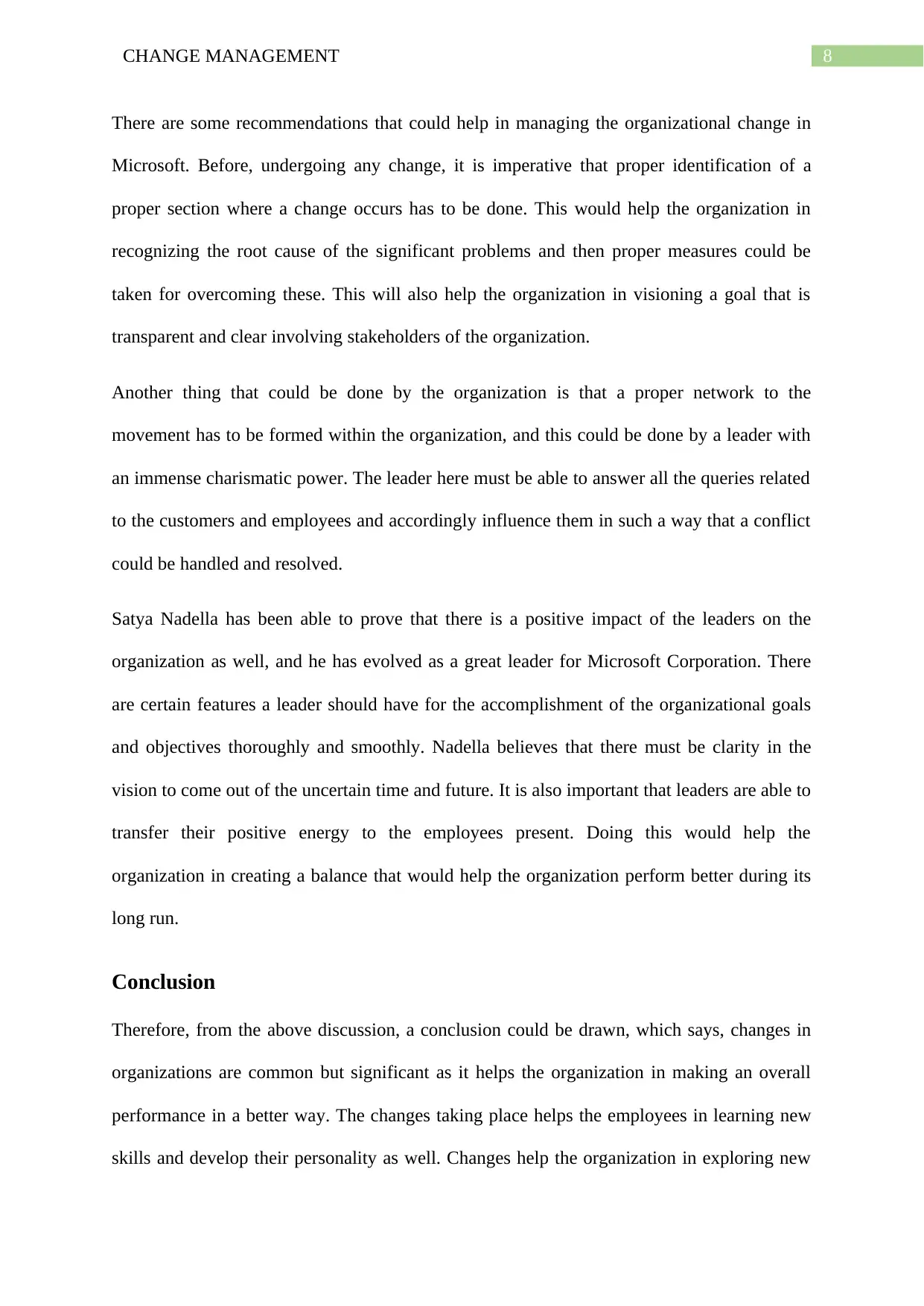
8CHANGE MANAGEMENT
There are some recommendations that could help in managing the organizational change in
Microsoft. Before, undergoing any change, it is imperative that proper identification of a
proper section where a change occurs has to be done. This would help the organization in
recognizing the root cause of the significant problems and then proper measures could be
taken for overcoming these. This will also help the organization in visioning a goal that is
transparent and clear involving stakeholders of the organization.
Another thing that could be done by the organization is that a proper network to the
movement has to be formed within the organization, and this could be done by a leader with
an immense charismatic power. The leader here must be able to answer all the queries related
to the customers and employees and accordingly influence them in such a way that a conflict
could be handled and resolved.
Satya Nadella has been able to prove that there is a positive impact of the leaders on the
organization as well, and he has evolved as a great leader for Microsoft Corporation. There
are certain features a leader should have for the accomplishment of the organizational goals
and objectives thoroughly and smoothly. Nadella believes that there must be clarity in the
vision to come out of the uncertain time and future. It is also important that leaders are able to
transfer their positive energy to the employees present. Doing this would help the
organization in creating a balance that would help the organization perform better during its
long run.
Conclusion
Therefore, from the above discussion, a conclusion could be drawn, which says, changes in
organizations are common but significant as it helps the organization in making an overall
performance in a better way. The changes taking place helps the employees in learning new
skills and develop their personality as well. Changes help the organization in exploring new
There are some recommendations that could help in managing the organizational change in
Microsoft. Before, undergoing any change, it is imperative that proper identification of a
proper section where a change occurs has to be done. This would help the organization in
recognizing the root cause of the significant problems and then proper measures could be
taken for overcoming these. This will also help the organization in visioning a goal that is
transparent and clear involving stakeholders of the organization.
Another thing that could be done by the organization is that a proper network to the
movement has to be formed within the organization, and this could be done by a leader with
an immense charismatic power. The leader here must be able to answer all the queries related
to the customers and employees and accordingly influence them in such a way that a conflict
could be handled and resolved.
Satya Nadella has been able to prove that there is a positive impact of the leaders on the
organization as well, and he has evolved as a great leader for Microsoft Corporation. There
are certain features a leader should have for the accomplishment of the organizational goals
and objectives thoroughly and smoothly. Nadella believes that there must be clarity in the
vision to come out of the uncertain time and future. It is also important that leaders are able to
transfer their positive energy to the employees present. Doing this would help the
organization in creating a balance that would help the organization perform better during its
long run.
Conclusion
Therefore, from the above discussion, a conclusion could be drawn, which says, changes in
organizations are common but significant as it helps the organization in making an overall
performance in a better way. The changes taking place helps the employees in learning new
skills and develop their personality as well. Changes help the organization in exploring new
⊘ This is a preview!⊘
Do you want full access?
Subscribe today to unlock all pages.

Trusted by 1+ million students worldwide
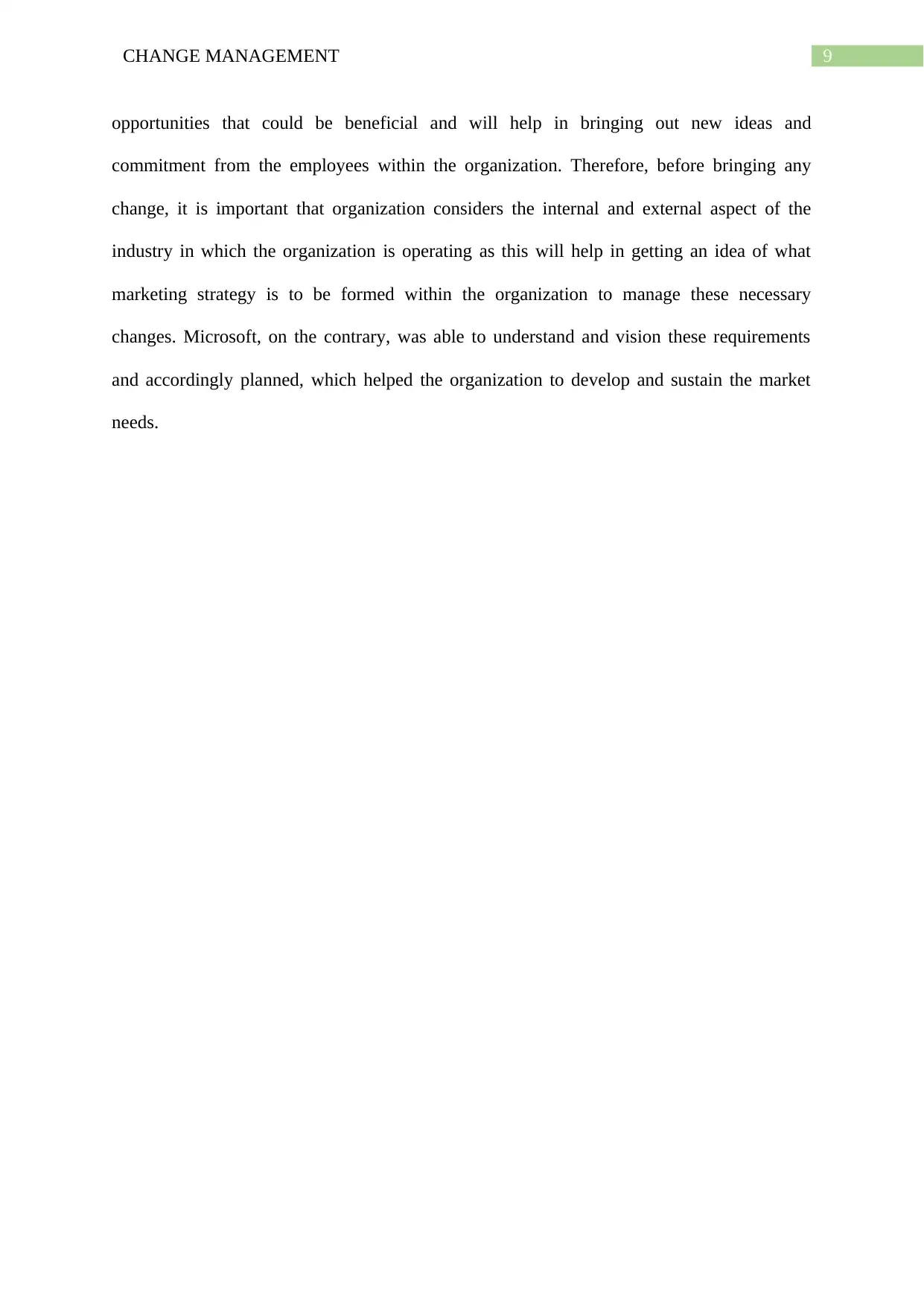
9CHANGE MANAGEMENT
opportunities that could be beneficial and will help in bringing out new ideas and
commitment from the employees within the organization. Therefore, before bringing any
change, it is important that organization considers the internal and external aspect of the
industry in which the organization is operating as this will help in getting an idea of what
marketing strategy is to be formed within the organization to manage these necessary
changes. Microsoft, on the contrary, was able to understand and vision these requirements
and accordingly planned, which helped the organization to develop and sustain the market
needs.
opportunities that could be beneficial and will help in bringing out new ideas and
commitment from the employees within the organization. Therefore, before bringing any
change, it is important that organization considers the internal and external aspect of the
industry in which the organization is operating as this will help in getting an idea of what
marketing strategy is to be formed within the organization to manage these necessary
changes. Microsoft, on the contrary, was able to understand and vision these requirements
and accordingly planned, which helped the organization to develop and sustain the market
needs.
Paraphrase This Document
Need a fresh take? Get an instant paraphrase of this document with our AI Paraphraser
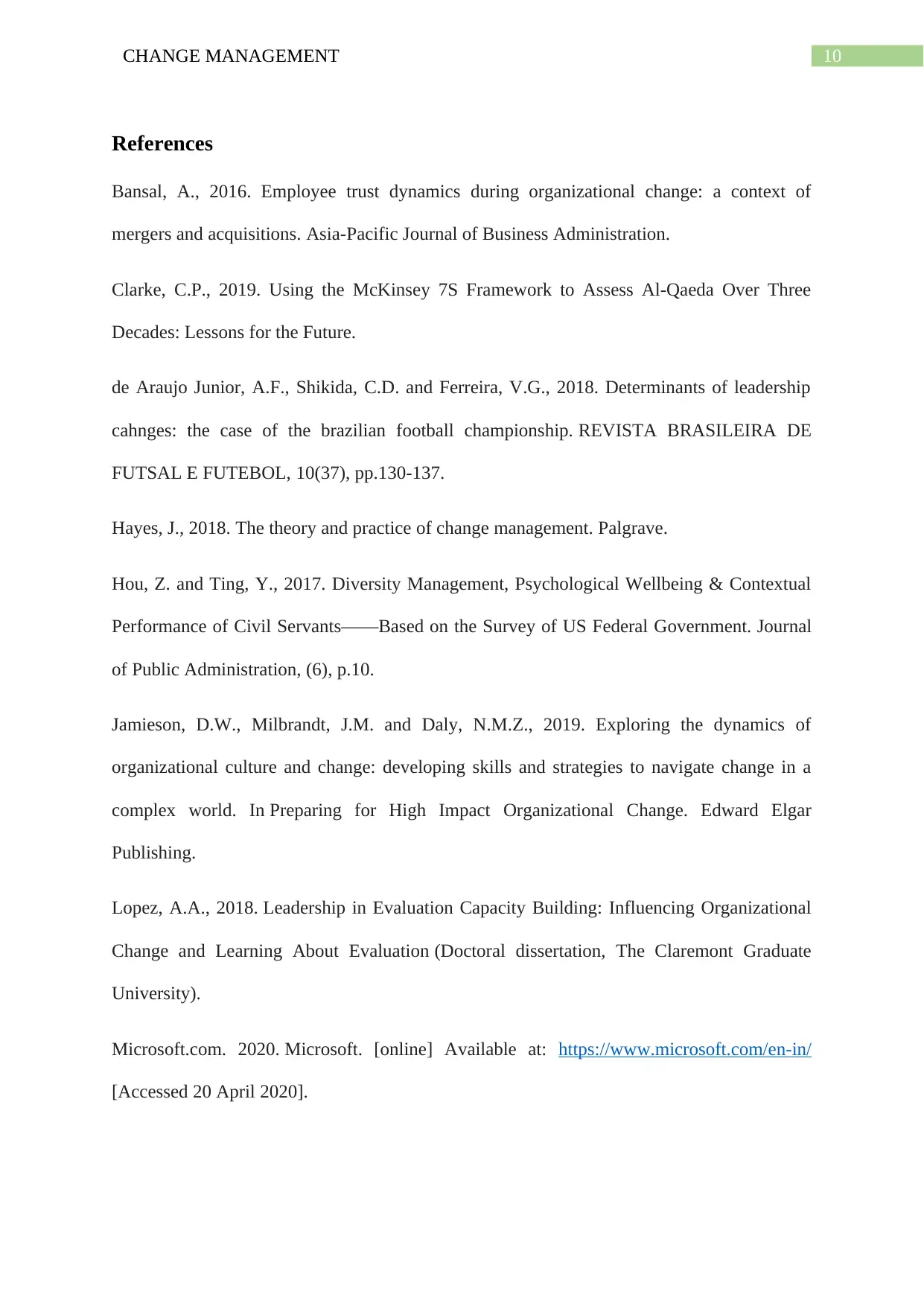
10CHANGE MANAGEMENT
References
Bansal, A., 2016. Employee trust dynamics during organizational change: a context of
mergers and acquisitions. Asia-Pacific Journal of Business Administration.
Clarke, C.P., 2019. Using the McKinsey 7S Framework to Assess Al-Qaeda Over Three
Decades: Lessons for the Future.
de Araujo Junior, A.F., Shikida, C.D. and Ferreira, V.G., 2018. Determinants of leadership
cahnges: the case of the brazilian football championship. REVISTA BRASILEIRA DE
FUTSAL E FUTEBOL, 10(37), pp.130-137.
Hayes, J., 2018. The theory and practice of change management. Palgrave.
Hou, Z. and Ting, Y., 2017. Diversity Management, Psychological Wellbeing & Contextual
Performance of Civil Servants——Based on the Survey of US Federal Government. Journal
of Public Administration, (6), p.10.
Jamieson, D.W., Milbrandt, J.M. and Daly, N.M.Z., 2019. Exploring the dynamics of
organizational culture and change: developing skills and strategies to navigate change in a
complex world. In Preparing for High Impact Organizational Change. Edward Elgar
Publishing.
Lopez, A.A., 2018. Leadership in Evaluation Capacity Building: Influencing Organizational
Change and Learning About Evaluation (Doctoral dissertation, The Claremont Graduate
University).
Microsoft.com. 2020. Microsoft. [online] Available at: https://www.microsoft.com/en-in/
[Accessed 20 April 2020].
References
Bansal, A., 2016. Employee trust dynamics during organizational change: a context of
mergers and acquisitions. Asia-Pacific Journal of Business Administration.
Clarke, C.P., 2019. Using the McKinsey 7S Framework to Assess Al-Qaeda Over Three
Decades: Lessons for the Future.
de Araujo Junior, A.F., Shikida, C.D. and Ferreira, V.G., 2018. Determinants of leadership
cahnges: the case of the brazilian football championship. REVISTA BRASILEIRA DE
FUTSAL E FUTEBOL, 10(37), pp.130-137.
Hayes, J., 2018. The theory and practice of change management. Palgrave.
Hou, Z. and Ting, Y., 2017. Diversity Management, Psychological Wellbeing & Contextual
Performance of Civil Servants——Based on the Survey of US Federal Government. Journal
of Public Administration, (6), p.10.
Jamieson, D.W., Milbrandt, J.M. and Daly, N.M.Z., 2019. Exploring the dynamics of
organizational culture and change: developing skills and strategies to navigate change in a
complex world. In Preparing for High Impact Organizational Change. Edward Elgar
Publishing.
Lopez, A.A., 2018. Leadership in Evaluation Capacity Building: Influencing Organizational
Change and Learning About Evaluation (Doctoral dissertation, The Claremont Graduate
University).
Microsoft.com. 2020. Microsoft. [online] Available at: https://www.microsoft.com/en-in/
[Accessed 20 April 2020].
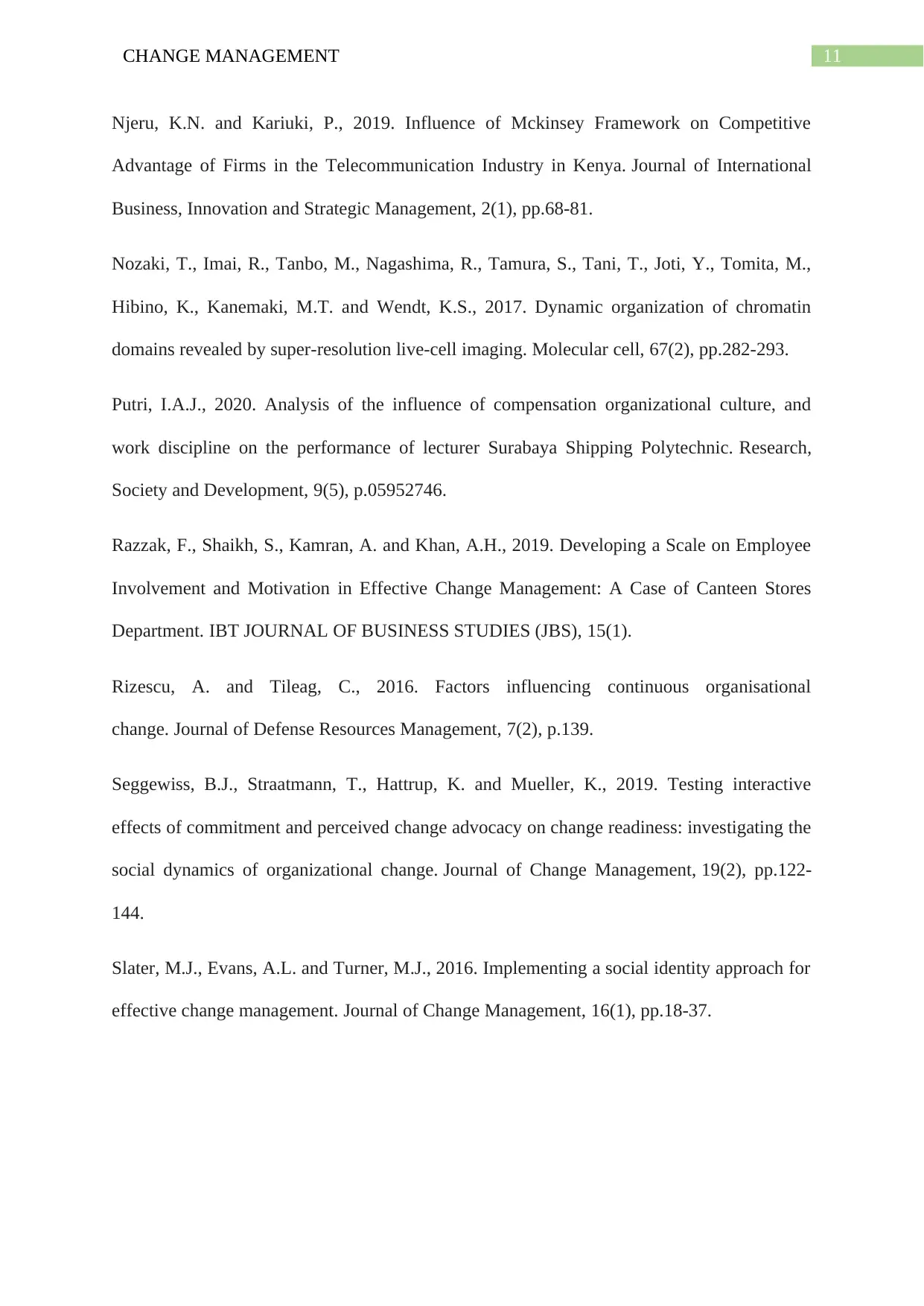
11CHANGE MANAGEMENT
Njeru, K.N. and Kariuki, P., 2019. Influence of Mckinsey Framework on Competitive
Advantage of Firms in the Telecommunication Industry in Kenya. Journal of International
Business, Innovation and Strategic Management, 2(1), pp.68-81.
Nozaki, T., Imai, R., Tanbo, M., Nagashima, R., Tamura, S., Tani, T., Joti, Y., Tomita, M.,
Hibino, K., Kanemaki, M.T. and Wendt, K.S., 2017. Dynamic organization of chromatin
domains revealed by super-resolution live-cell imaging. Molecular cell, 67(2), pp.282-293.
Putri, I.A.J., 2020. Analysis of the influence of compensation organizational culture, and
work discipline on the performance of lecturer Surabaya Shipping Polytechnic. Research,
Society and Development, 9(5), p.05952746.
Razzak, F., Shaikh, S., Kamran, A. and Khan, A.H., 2019. Developing a Scale on Employee
Involvement and Motivation in Effective Change Management: A Case of Canteen Stores
Department. IBT JOURNAL OF BUSINESS STUDIES (JBS), 15(1).
Rizescu, A. and Tileag, C., 2016. Factors influencing continuous organisational
change. Journal of Defense Resources Management, 7(2), p.139.
Seggewiss, B.J., Straatmann, T., Hattrup, K. and Mueller, K., 2019. Testing interactive
effects of commitment and perceived change advocacy on change readiness: investigating the
social dynamics of organizational change. Journal of Change Management, 19(2), pp.122-
144.
Slater, M.J., Evans, A.L. and Turner, M.J., 2016. Implementing a social identity approach for
effective change management. Journal of Change Management, 16(1), pp.18-37.
Njeru, K.N. and Kariuki, P., 2019. Influence of Mckinsey Framework on Competitive
Advantage of Firms in the Telecommunication Industry in Kenya. Journal of International
Business, Innovation and Strategic Management, 2(1), pp.68-81.
Nozaki, T., Imai, R., Tanbo, M., Nagashima, R., Tamura, S., Tani, T., Joti, Y., Tomita, M.,
Hibino, K., Kanemaki, M.T. and Wendt, K.S., 2017. Dynamic organization of chromatin
domains revealed by super-resolution live-cell imaging. Molecular cell, 67(2), pp.282-293.
Putri, I.A.J., 2020. Analysis of the influence of compensation organizational culture, and
work discipline on the performance of lecturer Surabaya Shipping Polytechnic. Research,
Society and Development, 9(5), p.05952746.
Razzak, F., Shaikh, S., Kamran, A. and Khan, A.H., 2019. Developing a Scale on Employee
Involvement and Motivation in Effective Change Management: A Case of Canteen Stores
Department. IBT JOURNAL OF BUSINESS STUDIES (JBS), 15(1).
Rizescu, A. and Tileag, C., 2016. Factors influencing continuous organisational
change. Journal of Defense Resources Management, 7(2), p.139.
Seggewiss, B.J., Straatmann, T., Hattrup, K. and Mueller, K., 2019. Testing interactive
effects of commitment and perceived change advocacy on change readiness: investigating the
social dynamics of organizational change. Journal of Change Management, 19(2), pp.122-
144.
Slater, M.J., Evans, A.L. and Turner, M.J., 2016. Implementing a social identity approach for
effective change management. Journal of Change Management, 16(1), pp.18-37.
⊘ This is a preview!⊘
Do you want full access?
Subscribe today to unlock all pages.

Trusted by 1+ million students worldwide
1 out of 12
Related Documents
Your All-in-One AI-Powered Toolkit for Academic Success.
+13062052269
info@desklib.com
Available 24*7 on WhatsApp / Email
![[object Object]](/_next/static/media/star-bottom.7253800d.svg)
Unlock your academic potential
Copyright © 2020–2025 A2Z Services. All Rights Reserved. Developed and managed by ZUCOL.





